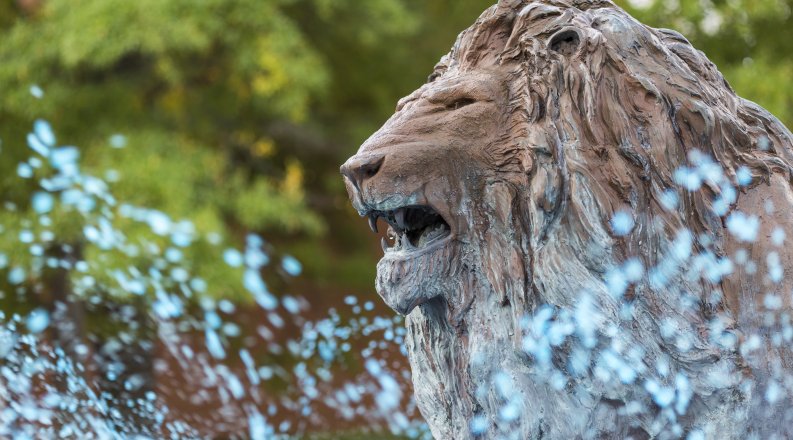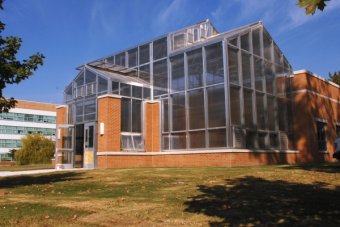Kaplan Orchid Conservatory
Beneath a lattice of rafters, fans and metal tubing, almost every square inch of ODU's orchid conservatory is bursting with life. Even areas to walk and observe flora struggle to hold back plants sprouting through cracked pavement.
The greenhouse is a drastic departure from the surrounding campus. A step inside meets a kaleidoscopic rush of perfume-like smells and saturated colors across the visible spectrum.
Marcus Jones controls this world — the temperature, humidity, ventilation, irrigation, the life or the death of these rare and exotic species are all at his fingertips. There are plants from all over the planet; Africa's Miracle fruit, South America's Amazon lily, Hawaii's Baby Woodrose and Asia's Artic Snow. From the side walls of the greenhouse, warm sprays of mist envelop the dazzling array of plants every so often, producing a cross between the sound of a rainforest symphony and the hiss of a serpent.
Vines and ferns scale the back wall in tandem with more metal tubes that allow for control of the greenhouse with exact precision. Conditions in the structure are computerized and accessible to Jones through an app on his phone. He only tampers with his world seasonally.
This artificially crated world fits in a small room just 50 feet by 25 feet across. It is one of five carefully controlled greenhouses in the $2.1 million structure, totaling a space of 30,000 square feet.
It's called the display room. The plants here grow in every shape and color imaginable- some endangered and a few extinct in nature. One has leaves stained blood-red around spots of green. There's a bizarre-shaped spectacle of a flower, bright orange and hiding below a thicket of ferns. There's a leopard printed flower and a seemingly prehistoric species with leaves around 4 feet long and 3 feet wide. In the corner, a small pond with lily pads sits next to a wooden adirondack chair overlooking the display. The orchids are the star of the show, but one piece of a larger symphony. Jones and the botanists oversee the orchestra.
"We do a lot of stuff here besides orchids," he says. Jones's office is only a few feet away from the jungle on campus. With a younger assistant, he opens his door, clipboard-in-hand, and steps outside in a rush to enter the room of plants.
He's wearing sunglasses, a green sweater zipped to his neck, blue jeans and grey slippers. He's not exactly a hippie, but he is hip. "Walk with me," he says. Jones is heading towards the Mills Godwin Life Sciences Building to speak with five other botanists about an experiment. They plan to take a russet potato and grow it within fungal soil media that supports a Lady Slipper orchid.
On the way to MGB, Jones explains why orchids are special."Orchids adapt," he says, "to so many different climates and so many different areas of the world. They're everywhere."
The conservatory allows the biology department to study conservation efforts for struggling stands of orchids, which offer a unique look at how evolution takes place. They also serve an essential role in the pollination process and the abundance of biodiversity- which is another research focus for the ODU biology department.
The elevator door opens to the fourth floor of MGB and Jones walks across the hall into another botany lab.
"They'll put anything in these experiments," says Peter Schafran, another botanist accompanying Jones on the walk. "It's like they'll take their own lunch and stick it in there." The idea is to see if the presence of a potato — or any other species for that matter — could produce germination in the Lady Slipper orchid. Another botanist suggests experimenting with a pineapple or a tomato.
"Let's do one at a time," says Schafran.
After the rendezvous with other botanists, Jones heads back to his office in the greenhouse. On the way, he points out plants outside of MGB that once grew within the greenhouse.
"We're planting more plants that are coastal plain natives," he says.
The coastal plants play a role in fostering an ecosystem of birds, insects and other animals, while performing another function of taking in water. Sea level rise is a growing research interest both throughout ODU and for researchers in the biology department.
The presence of roads, buildings and sidewalks magnify the intensity of flooding as water is unable to permeate into surfaces. Because of this, botanists are interested in studying the ability of plants to absorb higher quantities of water.
"It's an interesting subject," said Jones. "It plays into everything that most people see in cities."
"So you take a plant like Bald Cypress, which grows normally in swamps. But it also grows well in roadside medians," he says. "Look at California, the way everything's been planted out there for years and years and years and years. Now they're running out of water, maybe that's going to change the whole idea of what should be planted."
One way the botanists tackled sea level rise was through a wetlands restoration project just behind Brock Commons on Monarch Way.
"A lot of the native plants that went in there, we grew 'em here," said Jones. "We helped them get aquatic plants in there to help with that uptake of water and nutrients, and to clean up that system."
In addition to improving the ecological community, Jones wants the greenhouse to foster the social community as well.
The greenhouse is used for outreach and education for this purpose. Around 475 species are included in the collection and it is open to the public. About 1,000 people a year visit the conservatory for tours, classes and other events.
Materials in the greenhouse have been used in courses at ODU including Botany, Ethnobotany, Biology and Evolutionary Biology. Even English, Art, Philosophy and Photography students have drawn inspiration from greenhouse. The botanists are also involved with projects that include butterfly gardens around campus, research with the Smithsonian Institute, education with local school children and stormwater and wetlands restoration projects with the city.
Over five years of curating the greenhouse, Jones has seen all sorts people transiently admiring his display. He enjoys talking about the people who visit just as much as the plants themselves. "People come here for different reasons," he says. "Sometimes people come here because they love plants. Other people come here and just sit in the front and do homework." Some people stay longer and for reasons that are deeper.
"For the longest time I had a couple people that came in here for religious reasons. Not that this place is religious, but it's quiet, and it's warm in the winter time. They would sit and just think," Jones says.
"One volunteer is 78 and she graduated ODU in 1959. She comes in every Monday, Wednesday and Friday. So I have a different number of people that come in."
ODU's orchid conservatory attracts visitors from near and far. It is the largest orchid collection in the Tidewater region of Virginia. The display greenhouse is usually open to visitors from 10:00 a.m. to 2:00 p.m., most weekdays.




